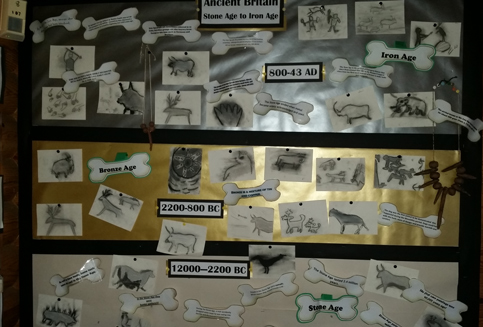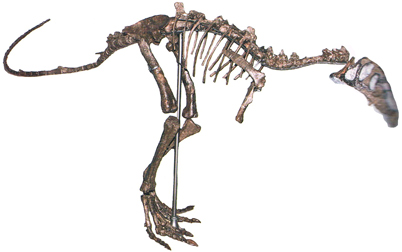Answering Great Questions from Young Dinosaur Fans
Questions from Young Dinosaur Fans
Time to catch up on our mailbag and in particular to tackle some of those tricky questions posed by young dinosaur fans. Everything Dinosaur gets sent emails, letters drawings, pictures and photographs of school displays – all about prehistoric animals and life in the past. We do our best to respond to all that we receive and to reply to those that require a reply. For example, we were sent in a lovely photograph from a school near Bath, (south-west England) of the Year Six work on the Stone Age. Charcoal drawings recreated cave paintings and the children used bone shapes to write facts about life in the past (they enjoyed seeing our Woolly Mammoth fossils too).
Stone Age Studies (Year 6)
Picture credit: Combe Down Primary/Everything Dinosaur
Our thanks to the school for showing us their wonderful classroom display.
Answering Questions
Was Eustreptospondylus a strong predator?
Eustreptospondylus oxoniensis is one of our favourite dinosaurs. The name means “Oxford’s well curved vertebrae”, as the single, partial specimen assigned to this genus was found at the bottom of a clay pit in Wolvercote, Oxfordshire (England). Eustreptospondylus was a member of the Megaloasauridae family (most likely), and although the fossils represent a juvenile it has been estimated that this meat-eating dinosaur grew to lengths in excess of six metres and it weighed more than half a tonne.
It would have been one of the most dangerous dinosaurs around during the Middle Jurassic, so yes it was a formidable and strong predator.
The Mounted Specimen of Eustreptospondylus (Wolvercote Specimen)
Picture credit: Everything Dinosaur/Siri Scientific Press
Questions About Theropod Dinosaurs
Who was bigger Suchomimus or Ichthyovenator?
These two dinosaurs are members of the Spinosauridae family. They lived at roughly the same time (120-112 million years ago), but in very different places. The one specimen of Ichthyovenator found to date comes from Laos in south-east Asia, whilst Suchomimus lived in Niger (Africa). Based on the fossils found it seems that Suchomimus was larger and heavier. Suchomimus has been estimated to have been around 11 metres in length and approximately 3 tonnes, whereas Ichthyovenator may have reached lengths in excess of nine metres and probably weighed about half as much as a fully grown Suchomimus.
Who was bigger Ichthyovenator or Neovenator?
A supplementary question with a request for information about Neovenator salerii. Known from just one specimen discovered in 1978 at Brighstone Bay (Isle of Wight), Neovenator provided the first direct evidence that allosaurs similar to those that roamed the western United States also lived in Europe. It was around 10 metres long and it weighed as much as 1.5-2 tonnes. It would have been an apex predator, hunting and killing other dinosaurs. Intriguingly, the Neovenator fossils show that this dinosaur had a very tough existence.
Its bones display signs of healed wounds (pathology). Some of the ribs had been broken, vertebrae cracked and this particular dinosaur has suffered a nasty injury to its chest. As these wounds had healed, the dinosaur had survived these injuries, as to their cause, they probably came about from fights with other dinosaurs.
Hypsilophodon
Where have fossils of Hypsilophodon been Found?
The small ornithopod called Hypsilophodon was one of the first dinosaurs to be named and described, it being studied prior to the great fossil hunting expeditions that took place in America during the 1870s. Fossils of this small dinosaur are associated with the Isle of Wight (England) and Spain.
What is Everything Dinosaur’s Favourite Dinosaur Model Series?
We are very lucky to have worked with lots of very clever and enthusiastic model making companies. We don’t really have a particular favourite.
Who was bigger Bahariasaurus or Edmarka?
Bahariasaurus (B. ingens) is known from a substantial shoulder girdle and several other bones that were unfortunately, all destroyed in the Second World War. It was a large, predator perhaps reaching lengths of 11 metres or more. It is believed to have lived during the Late Cretaceous, but an exact date for the fossil material assigned to this specimen cannot be given. Bahariasaurus’s taxonomic relationship with other theropods (where it sits on the theropod family tree), is disputed. It may have been related to Carcharodontosaurus or perhaps it was an abelisaurid.
It lived in a coastal swamp and the long leg bones indicate that it was a speedy runner. Bahariasaurus could be a specimen of Deltadromeus (D. agilis), another meat-eating dinosaur from the Late Cretaceous of North Africa, if this is the case then Bahariasaurus was actually more closely related to the ceratosaurs.
Discussing Edmarka
Edmarka too, is having a bit of an identity crisis. It is known from at least three partial specimens, one of which represents a very young animal. Fossils of parts of the skull, ribs and a scapula (shoulder bone) have been found in Morrison Formation exposures located in Wyoming. The name Edmarka rex was erected in 1992, (Bakker, Krails, Siegworth and Filla), but the fossils might represent Torvosaurus tanneri which was named in 1979. If this is the case then Edmarka becomes a junior synonym of Torvosaurus.
The species name “rex” was in recognition that this dinosaur was probably the largest and heaviest predator around the western United States at the time. It was around 11 metres long, making it roughly the same size of Bahariasaurus. More fossils are required before palaeontologists can present further information related to these two theropods.
Visit Everything Dinosaur’s website to view dinosaur replicas and prehistoric animal toys: Visit Everything Dinosaur.



